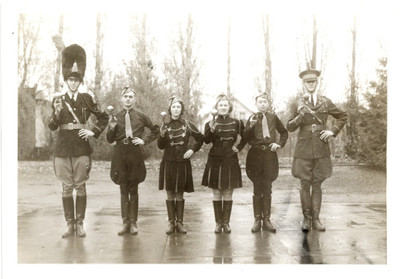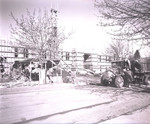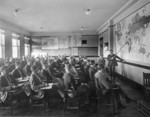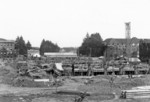
As the First World War ended, on campus there were still reminders of the war. ROTC remained prominent on campus and training was also conducted. The Memorial Union was constructed in remembrance of the men who died in the war. Ground was broken on March 3, 1926 and it was dedicated on June 1, 1929 as a living memorial to "the service and inspiration of the living and the memory of our immortal dead."[1] However, the cornerstone was laid previous to this on June 1, 1928 and the building was open to students and public for the first time. The Memorial Union was the first student union in the state and was built through contributions made by students and alumni, with the final design was from a 1907 OSU alumni, Lee Thomas. The building remained virtually unchanged until fall term of 1960 when the two wings were added at each end of the building for the bookstore and dining commons.
Along with the MU, the infirmary was one of only two major campus structures completed during the 15-year period from 1930 until the end of World War II. Constructed as a Public Works Administration (PWA) project, the building was funded with a $20,000 outright grant and an $80,000 loan.
There were also changes in name for the College along with the additions of these two buildings. In 1927, the name of the institution changed to Oregon State Agricultural College.[2] And five years later in 1932 the school again changed its name to Oregon State College in common usage.[3] However, the official name used in the catalogues, Oregon State Agricultural College, did not change until 1937.

OAC Cadets perform exhibition battle scene on the athletic field, during the Military Tournament 1927. The photo originally appeared in the 1927 Beaver Yearbook, page 267 under the title "Sham Battle". Of note is the use of WWI surplus equipment, this includes the style of helmet and gas masks as well.

Machine Gun training post WWI beside Armory, c. 1920. Cadets are seen training with the Browning M1917A1 .303 Water Cooled machine gun. This photo, probably just after WWI shows training cadets in setting up and firing the gun.

The infirmary was one of only two major campus structures completed during the 15-year period from 1930 until the end of World War II. Constructed as a Public Works Administration (PWA) project, the building was funded with a $20,000 outright grant and an $80,000 loan.

Military encampment on campus adjacent to Weatherford Hall, ca. 1936. Period vehicles including trucks and sedans. Tents of different configurations from 2 man "pup tents" to larger personnel tents. Photograph was originally published image in Beaver Yearbook, 1936.


